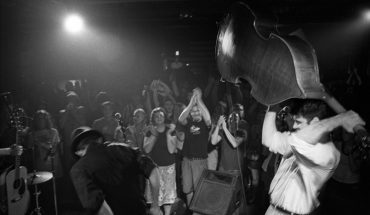
from left, RFAS charter members Matilda Parker, Betty Fitzgerald, Peggy Nowell, Charlotte Creech, Karin Stephens, Marion Church, Ann Walker, Sue Jenkins, Peg Fisher, and Martha Zaytoun.
by Marion Church, President, Raleigh Fine Arts Society
photograph by Jillian Clark
As the Raleigh Fine Arts Society welcomes our 50th year, we have thriving organization and a vibrant local arts culture to celebrate. Since 1964, when we began putting on exhibits of local artists in a library basement, RFAS has worked to foster and nurture the arts in our community. When we were inducted into the Raleigh Hall of Fame in October, we took a moment to reflect on where we’ve come from, where we’re headed, and the current state of the arts in Raleigh.
In our first half-century, we’ve built docent programs at the North Carolina Museum of Art, the Governor’s Mansion, and several other historic sites. We’ve created an annual literary contest for high school students that receives hundreds of entries every year; a prestigious juried artist’s exhibition for North Carolina artists; and a choral celebration that welcomes elementary students from all over the county to the stage of majestic Meymandi Concert Hall. We’ve developed outreach programs to bring art to the schools; helped restore the Pullen Park carousel; and donated tens of thousands of volunteer hours at arts organizations large and small.
In the beginning, nobody knew how much we could accomplish. Back in the early 1960s, our town offered little opportunity for exposure, encouragement, or education in the field of visual art, as local artist and Raleigh Fine Arts member Marriott Little recalls. “The art scene was in its infancy. There was no venue for talented artists to compete or to view the artwork of their peers. The RFAS Artists’ Exhibition was a pioneer.”
She’s right, and it’s worth remembering where we were back then. At the time – 1964-65 – Beatlemania was rampant in America, the Vietnam War was escalating, and someone in the Olivia Raney Library in Raleigh was probably putting Hemmingway’s new novel, A Moveable Feast, on the shelf. Up the street stood the North Carolina Museum of Art, then cramped in the old Highway Building, where a group of docents were likely preparing to give a group of teenagers (girls in miniskirts and guys with longer hair) their tour – but the truth is, those docents and some of their friends wanted to do more to educate, more to nurture, and more to celebrate the arts in our community.
About the same time, Jimmy Thiem, a local art supporter, suggested to the trustees of the Olivia Raney Library that their basement auditorium would be a perfect venue for an exhibition. And a young Raleigh teenager, Herb Jackson, was selected for a one-man show. Those NCMA docents, library staff, and other volunteers did the work. The show was a resounding success, and all involved agreed there was a need for an organization to support the arts in Raleigh. The Raleigh Fine Arts Society was born.
“The Art Museum was an important part of our formation,” says charter member Ann Walker. Our tie with the NCMA was our first relationship, and today it is as vibrant and honored as ever. Together, we have sponsored lectures and symposiums, and our members have served as museum docents and on various governing boards. The artist’s exhibition has grown as a result, becoming the first juried show for multi-media art in Wake County in 1978; expanding to welcome artists from around the state in 1997; and forming the content for a DVD to encourage and educate Wake County high school students.
The annual show “holds great prestige for those selected and has become a centerpiece of Raleigh’s commitment to the visual arts,” says Larry Wheeler, director of the NCMA. “As a former juror, I can attest to the high level of professionalism and artistic sensitivity which shapes the show.”
It is particularly thrilling to report that 50 years later, Herb Jackson, our original artist, is returning as juror for our 2015 Artists’ Exhibition. Herb’s illustrious career is one we all salute, and it will be a very special joy to have him with us as we celebrate our 50th year.
Another first for Raleigh Fine Arts was the creation of the Executive Mansion docent program in 1966. We received a request that year for help from Jeanelle Moore, the First Lady of North Carolina, to assist with tours of the house, its art, furnishings, and grounds. Today, approximately 50 of our members provide tours in our Governor’s home and beautiful gardens. “It is a privilege to serve in this capacity,” says member Carole Anders. “Docents at the Executive Mansion are North Carolina Ambassadors.”

Color In Light- Raleigh Fine Arts introduced sixth graders to color theory with a program designed by Joe Cox, professor of design at N.C. State. The program was donated to the Wake County public schools in 1996.
Broad reach
Over the years, RFAS volunteers have been involved at several other local historic properties, including Mordecai House, The Joel Lane House, and the NC Museum of History. We published Raleigh: A Guide to North Carolina’s Capital, and if you paid a visit to the Governor Morehead School for the Blind, you might have seen us helping children with tap dance classes.
We’ve created art outreach programs as well. They include Art in the Schools, a slide show about the American Collection at the NCMA, and the Color In Light program with Joe Cox, professor of design at N.C. State, which introduced 6th graders to the theory of color.
The restoration of Pullen Park’s Denzel Carousel, a true work of art circa 1900, is a project we are particularly proud to have accomplished. In 1976 we joined the Raleigh Department of Parks and Recreation in an effort to restore it to its previous beauty. We helped bring it to the attention of the public, hired a specialist to research original colors and decorative elements, raised funds, and worked with Archives and History to place this treasure on the National Register of Historic Places. The completed carousel, including the restored band organ, was dedicated in 1983.
Our second major annual project, the Literary Contest for Wake County high school students, began in the late ’70s and thrives today. Teachers have built it into their curriculums, and young writers have been created in the process. “They know it’s coming,” says Joyce Nelson, English instructor at W. G. Enloe High School. “It’s on the syllabus. They grumble and then they learn…about researching, writing, crafting, sharing and reading short stories.”
Hundreds of entries each year are judged by an experienced group of 80 writers and teachers. The winners receive cash prizes and are invited to a writer’s workshop and awards ceremony. We also sponsor a workshop the same evening for editors of school newspapers and magazines. Speakers at the awards ceremony have included authors Margaret Maron, Lee Smith, Doug Marlette and Reynolds Price.
This year, New York Times best-selling author Wiley Cash and his comedian brother Cliff Cash will have us on the edge of our seats. If you haven’t read Wiley’s books, do so…find a chair one chilly winter night, get comfy and prepare for a real literary journey!
Music, too
In 1998, charter member and former RFAS president Martha Zaytoun identified another exciting community need and project opportunity. The RFAS Choral Celebration was born, which promotes high standards in elementary choral music in Wake County. In the fall of each year, teachers participate in a choral literature workshop which leads to approximately 1,000 3rd, 4th and 5th grade children performing at the Duke Energy Center for the Performing Arts for two evenings in the spring.
It’s a once in a lifetime opportunity, say Wake County public schools music specialists Ann LeGarde, Anne Moorman-Smith and Ruth Pardue. Each year, a professional adjudicator gives written comments and suggestions to the choral directors of each school that they can learn from.What a joy it is to see our children on stage at Meymandi Hall and to hear the sound of their precious voices!
For 50 years, this organization has operated with no office and no staff – we remain totally volunteer-based – and yet we have never failed to insure that the visual, literary and performing arts are an important part of our community. We have also established a healthy endowment to ensure the future of our projects. In the process, at least two generations of our citizenry have benefitted directly or indirectly from our activities. The breadth of our projects is across the board; if you love the arts, there’s something for everyone!
“It is gratifying to know that the projects of RFAS really do matter when you see the sense of pride and accomplishment that shines on the faces of the singing children, the short story writers chosen for awards and the excitement of the artists selected for exhibition,” says member Jeanie Holmes. “They are encouraged by the acknowledgement of their dedication and hard work.”
Today, in addition to our three major projects, we continue our involvement with NCMA, the Executive Mansion, the N.C. Museum of History, The Gregg Museum, the Carolina Ballet, and the N.C. Symphony, and we continue to identify additional meaningful relationships in the arts in our community.
In the process, we hope to continue the legacy of our founding mothers and to fully impact our citizens, young and old, by fulfilling our mission “To further art in the community…and to encourage public appreciation, enthusiasm, support and understanding of art, music and literature.”
For more information on Raleigh Fine Arts and its programs: raleighfinearts.org.



